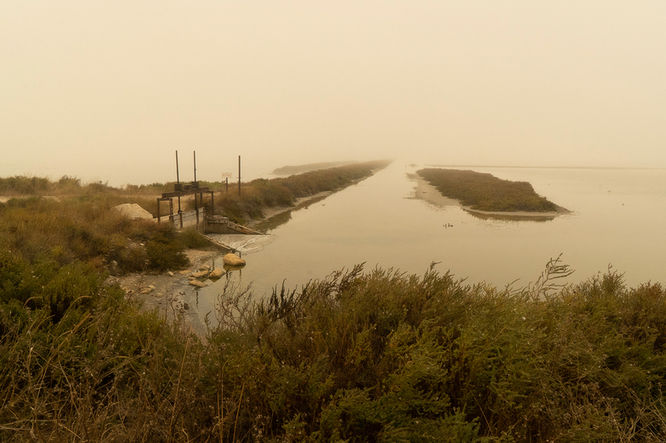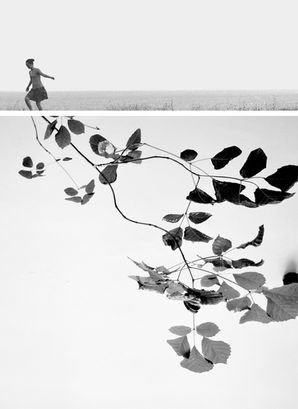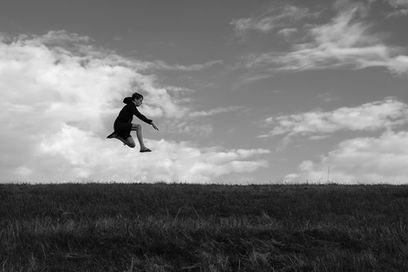
GROUNDED
May 3, 2021
INTERVIEW
PHOTOGRAPHY Samantha Brown
INTERVIEW Melanie Meggs
The world has been irrevocably changed by the events of 2020, and yet life must go on. For some, this has meant living a life of perpetual movement, in pursuit of a new normal, one where the need for physical connection is supplanted by the promise of virtual encounters. But for others, it has meant the chance to reconnect with the world in an entirely different way: through photography.
Samantha Brown is a British-Canadian photographer and digital nomad, and she has spent the last year living out of her camper van 'Juno', travelling safely in line with local lockdown restrictions, while also capturing the pandemic in all its beautiful, intricate detail. This journey of self-discovery and exploration has culminated in her first book, GROUNDED.
Samantha invites readers to join her on a journey full of visible beauty, underlying emotion and poignant reflections. From the empty streets of Bristol during the first lockdown, to the deserted ferry travelling through Europe during the easing of restrictions, Samantha's work captures the haunting out-of-season atmosphere that haunts every landscape she passes.
Samantha's documentation of this period of history provides us with a unique perspective, and offers an inspiring message of hope and promise amidst the darkness of a global pandemic. Through her story and her photography, she encourages us to look for the beauty in the world around us, no matter how uncertain the times may be.
We had the privilege of speaking to Samantha about her journey, her book GROUNDED and her life as a digital nomad. Read on to find out more about this inspiring individual and the incredible work she is producing.

“I became a digital nomad, after my father died from leukemia and my daughter left university. I didn’t get the chance to travel so much when I was much younger as I was busy raising my daughter as a single parent. Dad’s death made me reflect on how short life is. So I left my corporate marketing job and established my business as a freelancer marketing consultant, working from my laptop. I became interested in photography in 2017, when my Dad was first diagnosed. I found it to be the best form of meditation – taking in your surroundings, focusing on them, and producing something creative at the end of it. Photography never fails to make me happy, no matter how tough life is.”
IN CONVERSATION WITH SAMANTHA BROWN
THE PICTORIAL LIST: Samantha, congratulations on your first book 'Grounded', about your personal ten month socially distanced journey in 2020. Why did you decide to bring this series of work together as a book? What did you want to convey with it?
SAMANTHA BROWN: Thanks. During the Covid-19 pandemic of 2020, many people's perceived sense of home – of being ‘grounded’ – disappeared, overnight. Suddenly we found ourselves in a dystopian dream world, a world where our bedrooms became our offices, without boundaries or definition, where much yearned for social connection played out on a flat digital screen, and where touch became forbidden. When restrictions eased, I ventured to Europe in line with travel recommendations – but these feelings and perceptions travelled with me. And from this experience, this photobook was born. I wanted to create a record of how the pandemic has affected landscapes, and our sense of self within a place.
When I set off in Juno, as travel restrictions eased, I always knew that the journey would be a bit isolating. I’d anticipated this and even bought a van with its own bathroom and kitchen so I could be completely self-contained and not have to interact with people too much. But as I travelled down the west coast of France, I realised that the landscapes were utterly deserted. Beaches that would normally be teeming with tourists were empty. In some places – the Camargue for example – it felt like I was the last person left on earth.
It’s been lovely to receive feedback from readers who’ve purchased the book, and found it quite moving. I’ve had people say that the sense of isolation - as conveyed by the book - matched with their experience of the pandemic too.
TPL: Describe what it was like as a woman travelling solo in a campervan. What were some of the highlights and lowlights that you experienced on this journey? Was there anything you gained from this experience?
SB: Having travelled for a few years on my own now, I consider myself to be a reasonably seasoned traveller, but this was one of the hardest trips I’ve ever done. It was hard work juggling the demands of solo van life with driving and working. But on top of that, a number of unexpected small disasters happened. I ended up in Bordeaux on the way down on the hottest day on record for 50 years – and as a 1998 Peugeot Boxer auto-sleeper, Juno didn’t have aircon. On that day I woke up at 2am covered in insects and decided to keep driving until I got to the Mediterranean, as I knew there would be a sea breeze that would cool me off. When I got down to the Mediterranean, around a week later I was evacuated due to an out-of-control forest fire. Luckily Juno escaped the direction of the flames, but many other vans in local campsites were destroyed. I moved to the Camargue after that and unfortunately attracted the attentions of a rather dodgy guy, who would not leave me alone. I ended up moving to a secure gated campsite and making a police report.
There were many high points. I really loved the Camargue and the salt flats there, it is such a stunningly beautiful place with the most amazing light and sea mists which descend at the end of the day. I often felt like I was in a desert when I was there, the sense of peace was just wonderful. I loved taking photos as I travelled too and exploring the many facets of France – the mountains of the Pyrenees and Provence, the culture, food and wine. It’s an incredible country. And Juno was amazing. She never broke down or let me down once, and I’m very thankful for that.
TPL: What important bit of advice would you give to someone who was thinking of embarking on a similar journey?
SB: Consider having a van with aircon if you are planning to go to a country which might experience heat over 30 degrees Celsius. I don’t regret buying Juno as she has many amazing features but she just isn't suitable for southern Europe in early August, that’s for sure. Also there are some great apps which can show you where to park up for the night for free or a low cost – Park4Night is one of them.
TPL: Tell us about yourself. Describe your life as a digital nomad. When and how did you become interested in photography?
SB: I’m a 45 year old British-Canadian, and I was born in Wales. I count the city of Bristol in the UK as my home base – I’ve had a home and friends here for 24 years - although I often travel around whilst working (when there’s not a pandemic to contend with). Bristol is a very relaxed, creative and liberal place to live, with a strong music scene. My Canadian roots come from my Dad, who was born on Vancouver Island, British Columbia.
I became a digital nomad in 2019, after my father died from leukemia and my daughter left university. I didn’t get the chance to travel so much when I was much younger as I was busy raising my daughter Kaya as a single parent. Dad’s death made me reflect on how short life is. So I left my corporate marketing job and established my business as a freelancer marketing consultant, working from my laptop. The intention was to also dedicate more time to my photography as I travelled. I went to South and Central America, Bali, Thailand and India, traversing 11 countries, working as I went. It was an amazing journey and I made lots of fantastic friends along the way. I was in Goa when the pandemic caught up with me in March 2020, and I hastily left on one of the remaining commercial flights back home to the UK before the EU closed its borders. I spent the first lockdown in Bristol, before buying a campervan ('Juno') and travelling to France in the summer of 2020 when the lockdown travel restrictions eased.
I became interested in photography in 2017, when my Dad was first diagnosed. After about 9 months of fooling around with my iPhone, I bought a Sony A7 and taught myself how to use it. I found it to be the best form of meditation – taking in your surroundings, focusing on them, and producing something creative at the end of it. Photography never fails to make me happy, no matter how tough life is.
TPL: Where do you find your inspiration to create?
SB: I’m often moved by my emotion and also the landscapes around me. I also enjoy telling a story – I did a whole series in a chateau on the way home called L'Impasse, which was about an unhealthy relationship I found myself in whilst in France.
I tend to use self portraits mixed in with landscapes because I’m travelling by myself and there’s no models for me to use. And I don’t feel comfortable instructing people to move to fit my creative direction, so it’s simplest to use myself in shots and use a self timer.
TPL: When you take pictures, do you usually have a concept in mind of what you want to shoot, or do you let the images just 'come to you', or is it both? Describe your process.
SB: I used to enjoy travelling around and coming across treasures to photograph, in a spontaneous way. Photography is a bit like a treasure hunt in that respect.
But, increasingly I’m more interested in thinking through a creative concept and deciding how I want to shoot it. For myself, that process involves having an intuitive feel for what I want to convey, without thinking through every aspect of the detail, and then I let the photograph ‘happen’ when I get to the location.
I wanted to create a record of how the pandemic has affected landscapes, and our sense of self within a place.

TPL: Do you have any favourite artists or photographers you would like to share with us, and the reason for their significance?
SB: Many of the photographers that I really like and admire have an ability to convey feelings and emotions at a very subtle, almost unconscious level through their photography. I love the work of Tania Franco Klein, Elena Helfrecht and Guy Bourdin for that reason. Kadiya Qasem achieves a similar outcome with her British land and seascapes. I admire the creativity and maverick genius of Benoit Paille, and the bold creative direction of Juno Calypso, who uses incredibly stylised self portraits in her work. I also love the surrealism and mystery of Man Ray.
TPL: Where has been your most favourite place to photograph?
SB: Bolivia – the stark landscapes are out of this world, Scotland and the Camargue, in that order.
TPL: Does the equipment you use help you in achieving your vision in your photography? What camera do you use? Do you have a preferred lens/focal length?
SB: I have a rather old Sony A7 DSLR and a basic tripod, which I’m hoping to replace this year. I do love the Sony colours, especially in low light situations. My lens is a Sony f4 18-105mm. I don’t have any preference for focal length although I tend to avoid macro work. I’m a diehard light hunter, I use light and shade a lot to convey narrative.
TPL: What are some of your goals as an artist or photographer? Where do you hope to see yourself in five years?
SB: For me, it’s really important to just enjoy photography and to be as creative as I can possibly be with it. I don’t do photography for money, I do my marketing work for money so I can focus on being creative with my photography. So following on from that, the creativity must take precedence over everything.
I would love to create some more series over time and I hope that I can achieve that, that’s all. I’m also interested in exploring how I could use my photography in digital art. I have a lot to learn in that respect but I’m starting to think about it this year.
TPL: Are there any special projects you are currently working on that you would like to let everyone know about?
SB: I’ve got an artist’s residency up in Scotland in early June with Cromarty Arts Trust and I’m very interested in doing a project involving both the landscapes and the light, which will be incredible at that time of year. It gets light at 4.30am and dark at 11.30pm – so plenty of opportunity for messing around with a tripod in the dawn and dusk times – although I’m told the midges can be rather fierce at that time of year.
TPL: When I am not out photographing, I (like to)...
SB: Listen to music and dance with my friends at festivals. British festivals are world class – we love to party over here. Now I’ve had my vaccine, along with a large proportion of the adult population here, I’m really looking forward to some festivals opening up this Summer – provided lockdown continues to ease as planned.

Most often we get so consumed with the game of life – all of its pursuits, emotions, and experiences. We become distracted or lost. After the loss of her Dad, Samantha reflected on how short life is. So she left her job and became a digital nomad dedicating more time to her photography as she travelled. The Pictorial List would like to thank Samantha for sharing with us her inspirational story. Buy her book GROUNDED and follow Samantha on Instagram and experience her visual storytelling for yourself.












































